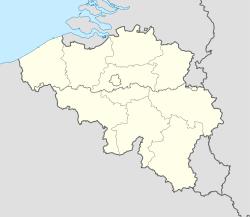Limbourg | |
|---|---|
Municipality | |
 Old centre of Limbourg | |
| Coordinates: 50°37′N 05°56′E / 50.617°N 5.933°E | |
| Country | Belgium |
| Community | French Community |
| Region | Wallonia |
| Province | Liège |
| Arrondissement | Verviers |
| Government | |
| • Mayor | Valérie Dejardin (PS) |
| • Governing party/ies | PS and MR-IC |
| Area | |
| • Total | 24.63 km2 (9.51 sq mi) |
| Population (2018-01-01)[1] | |
| • Total | 5,939 |
| • Density | 240/km2 (620/sq mi) |
| Postal codes | 4830-4834 |
| Area codes | 087 |
| Website | www.ville-limbourg.be |
Limbourg or Limbourg-sur-Vesdre [2] (German and Dutch: Limburg) is a city located in the province of Liège, Wallonia, Belgium.
On 1 January 2008 Limbourg had a total population of 5,680. The total area is 24.63 km² which gives a population density of 231 inhabitants per km². The present municipality of Limbourg was formed in 1977 by the merger of the old municipalities of Limbourg, Bilstain, and Goé.
Etymology and history
![]() Duchy of Lower Lorraine 1000–1065
Duchy of Lower Lorraine 1000–1065
![]() Duchy of Limburg 1065–1795
Duchy of Limburg 1065–1795
![]() Burgundian Netherlands 1430–1482
Burgundian Netherlands 1430–1482
![]() Habsburg Netherlands 1482–1556
Habsburg Netherlands 1482–1556
![]() Spanish Netherlands 1556–1714
Spanish Netherlands 1556–1714
![]() Austrian Netherlands 1714–1794
Austrian Netherlands 1714–1794
![]() French Republic 1795–1804
French Republic 1795–1804
![]() French Empire 1804–1815
French Empire 1804–1815
![]() Kingdom of the Netherlands 1815–1830
Kingdom of the Netherlands 1815–1830
![]() Kingdom of Belgium 1830–present
Kingdom of Belgium 1830–present
The second part of the name Limbourg is from burg meaning a fortified town, which is common in many parts of Europe where Germanic languages are spoken or have been spoken historically (see Germanic placename etymology). Concerning the first part of the name there are various theories. One is lint meaning "dragon". Another is that it refers back to the Roman-era limes, situated at boundaries of the Empire. It may also have been related to the material lim or lime.[3] Jean-Louis Kupper has proposed that the fort was named by its founder Frederick after Limburg Abbey in Germany, which in his lifetime had important connection to his imperial patrons and the Abbey of Stavelot, for which he was advowee.[4]
Limbourg is located on top of a hill which in its turn is surrounded by the river Vesdre. This was a strong military advantage in the Middle Ages and allowed the city to defend itself against foreign invaders. In the Middle Ages, the ruling family came to have the rank of duke and so the town was the seat of the Duchy of Limburg, which was a part of the Lower Lorraine region of the Holy Roman Empire.
The town featured in the War of the Spanish Succession, falling in 1703 to British and Dutch Republican forces led by the Duke of Marlborough. The lower part of the town, along the Vesdre, is called Dolhain.
See also
- List of protected heritage sites in Limbourg
- Duchy of Limburg
References
- ^ "Wettelijke Bevolking per gemeente op 1 januari 2018". Statbel. Retrieved 9 March 2019.
- ^ Occasionally formerly "Lambourg", as in the 1584 Treaty of Joinville.
- ^ Berkel and Samplonius, "Het Plaatsnamenboek", 1989, Unieboek, Houten
- ^ Jean-Louis Kupper (2007) Les origines du duché de Limbourg-sur-Vesdre", Revue belge de Philologie et d'Histoire Année 85-3-4 pp. 609-637 [1]





